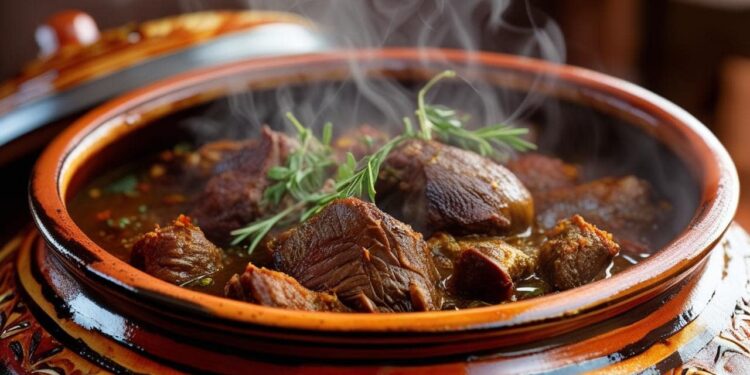Today, we’re diving into the best Moroccan savory dishes that have won the hearts of food lovers around the world. Known for its bold spices and fresh ingredients, Moroccan cuisine is celebrated by chefs like Gordon Ramsay and food fans everywhere. Whether you’re planning a trip to Morocco or just want to enjoy authentic flavors at home, this article will guide you through the must-try savory dishes—from comforting tagines to flavorful couscous.
We’ll cover these dishes in three parts: savory mains, traditional sweets and sauces, and popular soups and drinks. By the end, you’ll know exactly what makes Moroccan food so special and what to taste first.
Moroccan Savory Dishes: Salt dishes
1: Tajine
The famous Tajine, is the name of that clay bowl. This unique tagine pot has a cone shaped lid that helps keep the food moist and full of flavor. This Moroccan dish is made by slowly cooking meat, chicken, or vegetables with spices in a special pot called a tagine. The dish is usually served with bread and is known for its rich taste and fragrant spices, making it a popular and comforting meal in Moroccan culture.
2: Couscous
Moroccan couscous is a traditional dish made from small steamed balls of wheat semolina. It’s often served with a mix of vegetables like carrots, zucchini, and chickpeas, and can include meat such as chicken, lamb, or beef. Couscous is a staple in Moroccan cuisine and is usually enjoyed during family gatherings and special occasions. The dish is flavorful, thanks to a variety of spices that give flavor to that fabulous dish. This dish represents the rich culture and food traditions of Morocco. It is a tradition to eat couscous every Friday after the Jumu’ah prayer.
3: Rafissa
Rafissa is a traditional Moroccan dish made with shredded msemen or rghaif (Moroccan flatbread), served with a flavorful chicken and lentil stew. The dish is seasoned with a mix of spices like fenugreek, saffron, and ginger, giving it a rich and comforting taste. Rafissa is often prepared for special occasions, such as family gatherings or when celebrating the birth of a child. It’s a hearty and warm meal that showcases the depth of Moroccan cuisine and its use of spices and traditional bread.
4: Roasted chicken ( djaj mhamer)
Roasted chicken, known as djaj mhamer, is a popular dish enjoyed by both adults and kids. The chicken is marinated with a blend of spices such as cumin, paprika, saffron, and sometimes S’man, then slow-roasted until it is tender and flavorful. Djaj mhamer is typically served with a side of vegetables, salads, bread, and French fries. This dish is celebrated for its rich taste and aromatic spices, showcasing the depth of Moroccan culinary tradition.
5: Seffa
Seffa is a famous dish often served after Djaj Mhammer. In Morocco, it is common to have Djaj Mhammer and Seffa as part of the menu for special occasions. Seffa is made with steamed couscous or vermicelli noodles, often sweetened with powdered sugar and cinnamon. It is typically served with a mixture of almonds, raisins, and sometimes meat such as chicken or lamb. This dish is known for its unique blend of sweet and savory flavors, making it a popular choice for special occasions and festive gatherings. Seffa is a delightful example of Moroccan cuisine’s ability to combine diverse ingredients into a harmonious and satisfying meal.
6 : Pastilla
Pastilla, also known as Bastilla, is a famous Moroccan pastry that combines sweet and savory flavors in a unique way. This dish typically features a flaky, layered pastry filled with a spiced mixture of shredded chicken or pigeon, almonds, and eggs. The filling is seasoned with a blend of spices, then topped with powdered sugar and cinnamon before baking. Pastilla is often served as a luxurious appetizer or main course during special occasions. Its delicate texture and complex flavor profile make it a standout example of Moroccan cuisine’s creativity and richness. There is also a fish version of Bastilla, which contains a spiced fish filling instead of chicken or pigeon.
7: Meat ( Lham & barkouk)
Meat, known as Lham in Moroccan cuisine, is a staple ingredient in many traditional dishes. Lham typically refers to various types of meat, including beef, lamb, or goat, and is often used in flavorful stews and tagines. Barkouk, on the other hand, refers to a type of dried fruit, such as apricots or dates, that is sometimes added to meat dishes to provide a sweet contrast to the savory flavors. Together, Lham and Barkouk create a rich and balanced meal that highlights the diverse tastes of Moroccan cooking.
8: Meatball Tagine ( Kafta kwari )
Meatball Moroccan Tagine, known as Kafta Kiwari in Moroccan cuisine, is a delicious and hearty dish. This tagine features seasoned meatballs made from ground beef or lamb, mixed with spices like cumin, coriander, and paprika. The meatballs are cooked in a savory tomato-based sauce, often with onions, garlic, and sometimes olives or vegetables. The slow-cooking process in the tagine allows the flavors to meld together, resulting in a rich and flavorful meal. Kafta Kiwari is typically enjoyed with crusty bread and is a favorite in Moroccan households for its comforting and satisfying taste.
9: Fishball Tagine ( Sardine kwari )
Fishball Tagine, known as Sardine Kiwari in Moroccan cuisine, is a flavorful and unique dish made with spiced fish balls. Typically, sardines are ground and mixed with a blend of spices such as cumin, coriander, paprika, ras el hanout and garlic, along with fresh herbs like cilantro and parsley. These fish balls are then cooked in a tomato-based sauce with onions, garlic, and sometimes olives or vegetables. The slow-cooking process in the tagine allows the fish balls to absorb the rich flavors of the sauce, creating a delicious and aromatic meal. Sardine Kiwari is often enjoyed with crusty bread, and Moroccan salad.
10: Zaalouk
Zaalouk is a dish made from eggplant and tomatoes. This flavorful and savory salad is typically cooked with garlic, olive oil, and a mix of spices such as cumin, paprika, and coriander. The eggplant is usually roasted or grilled before being combined with the tomatoes and spices, creating a rich and smoky flavor. Zaalouk is often served as a side dish or appetizer, enjoyed with crusty bread or as part of a larger meal. Its vibrant taste and versatile nature make it a popular choice in Moroccan cuisine.
11: Taktouka
Taktouka is a popular salad made from roasted peppers and tomatoes. The peppers are usually grilled or charred, then peeled and chopped, while the tomatoes are cooked down into a rich, flavorful sauce. The mixture is sautéed with garlic, olive oil, and a blend of spices such as cumin and paprika, creating a savory and slightly spicy dish. Taktouka is often served also as a side dish or appetizer, accompanied by Moroccan bread or used as a topping for other dishes.
12: Adass
Adass is a Moroccan lentil stew known for its hearty and comforting qualities. This dish features lentils cooked in a savory broth with a mix of spices, and often includes ingredients like onions, garlic, and tomatoes. It can be enhanced with vegetables or small pieces of meat, such as Guedid. Guedid is a Moroccan dried meat, usually made from beef or lamb, which is salted and sun-dried to give it a strong, savory flavor.
This dried meat is commonly used in Moroccan dishes like couscous and tagines, and when added to Adass, it imparts an extra layer of depth to the stew. Adass is typically enjoyed as a main course, especially during colder months, and is often served with bread or sometimes fried sardines.
13: Loubia
Loubia is a traditional Moroccan dish made with white beans cooked in a savory tomato-based sauce. The beans are simmered with onions, garlic, and a blend of spices. This hearty and flavorful dish is often enjoyed with a side of crusty bread. Loubia is known for its comforting taste and is commonly served as a main course or side dish in Moroccan cuisine. Sometimes it is served as a main dish, and in some places in Morocco, meat such as lamb or beef heads may be added to give it an additional flavor.
Conclusion
Moroccan cuisine is incredibly rich and diverse, offering a wide range of flavors that truly represent the country’s culture. From the comforting Adass and Loubia to the unique sweet and savory Pastilla and Seffa, every dish provides a taste of Moroccan tradition. The spicy Kafta Kowari and flavorful Sardine Kowari highlight the variety in Moroccan food, while dishes like Taktouka and Zaalouk add even more depth. Preserved meats like Guedid bring their own special touch to the mix. Overall, Moroccan cuisine is not only about delicious food but also deeply rooted in tradition, making it a fantastic culinary adventure for anyone willing to try it.
Want more tasty recipes? Explore our Food category for more delicious dishes!
Q1: What are the most popular Moroccan savory dishes?
A: Some of the most popular Moroccan savory dishes include tagine (slow-cooked stews), couscous, bastilla (savory pie), and harira (traditional soup). These dishes are rich in spices and flavors unique to Moroccan cuisine.
Q2: What spices are commonly used in Moroccan savory dishes?
A: Moroccan cooking often uses spices like cumin, coriander, saffron, cinnamon, ginger, and ras el hanout—a special blend of spices that gives the dishes their distinct aroma and taste.
Q3: Are Moroccan savory dishes spicy hot?
A: Moroccan food is flavorful and aromatic but not necessarily very spicy hot. It’s more about warmth and depth of flavor rather than heat.
Q4: Can I make Moroccan savory dishes at home easily?
A: Yes! Many Moroccan dishes like tagines and couscous can be made at home using common ingredients and spices. You don’t always need special equipment—just some patience for slow cooking.
Q5: What is the difference between tagine and couscous?
A: Tagine refers to a slow-cooked stew usually made with meat, vegetables, and spices, cooked in a special clay pot called a tagine. Couscous is a dish made of steamed semolina grains often served with vegetables and meat.
Q6: Are Moroccan savory dishes suitable for vegetarians?
A: Absolutely! Many Moroccan dishes are vegetable-based or can be easily adapted to be vegetarian or vegan, such as vegetable tagines and lentil stews.










































